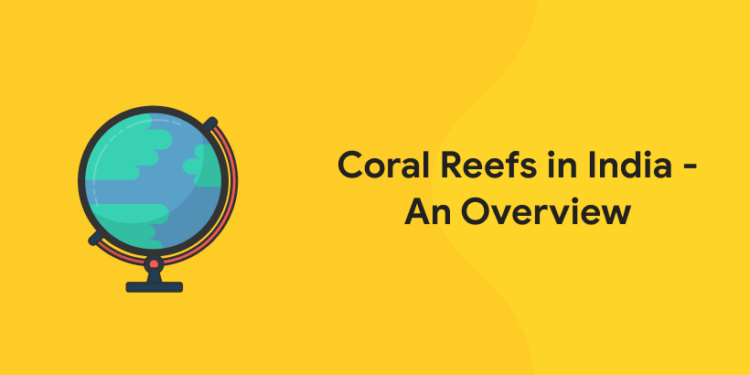Table of Contents
A coral reef is a structure in shallow ocean areas made up of colonies of hundreds to thousands of tiny individual corals, called polyps. Corals are small marine animals that live in oceans, from tropical to freezing temperatures, but build coral reefs in warm, shallow seas in the tropics. These marine invertebrate animals have hard exoskeletons made of calcium carbonate, and are sessile, which means that they are permanently fixed in one place. Assisted by other animals with calcium carbonate skeletons, corals form complex, three-dimensional reefs. Coral reefs provide an important ecosystem for marine life, offering food and shelter among their crevices and branches for animals including fishes, molluscs, sea urchins and sponges.
Coral reefs in India include some of the most diverse, extensive and least disturbed reef areas of the Indian Ocean, many of which are among the least scientifically known. In India, there are a total of 199 species divided among 37 genera.
Attempt Free Current Affairs Tests! Register Here!
How are Coral Reefs Formed?
Coral reefs are formed when the freely moving larvae of corals attach themselves to sedimentary rocks or hard surfaces near the coastlines. This process is undertaken with the help of several other processes like sedimentation, compaction, cementation and solidification of the skeletons of coral polyps.
Types of Coral Reefs
1: Who was the first woman President of India?
There are three major types of coral reefs in India:
- Fringing reefs – These are reefs that evolve and develop near the continent and grow close to the shore and extend out into the sea like a submerged platform. These reefs are separated from the coastline by small, shallow lagoons. These are found in Andaman and Nicobar Islands and Gulf of Mannar.
- Barrier reefs – They are found offshore on the continental shelf. These reefs are separated from the land by wide expanses of water and follow the coastline. A deep and wide lagoon is located between the coastline and the barrier reef. These are present in Andaman and Nicobar islands.
- Atolls – These are formed on mid-oceanic ridges. They are roughly circular ring of reefs surrounding a lagoon, a low lying island, common in the Indian and South pacific oceans. Lakshadweep is the only atoll union territory of India.
Attempt Free General Knowledge Quiz! Register Here!
Free UPSKILLING Courses!
Take your first step toward mastering in-demand skills, acing interviews, and securing top-tier jobs with Entri's free upskilling courses.
Start Learning!Coral Reefs in India
The total area of coral reefs in India is estimated to be 2,375 Sq. Km (DOD and SAC 1997). The Indian Ocean is the world’s third largest ocean, spanning from the east coast of Africa to the western shores of Australia. Due to its position along the equator, it is home to almost half of the world’s coral reefs, primarily around Indonesia, Australia and India.
Coral reefs in India are found in a lot of areas including the Gulf of Kutch, Gulf of Mannar, Palk Bay, Andaman & Nicobar and Lakshadweep Islands. The Gulf of Kutch in the northwest has some of the most northerly reefs in the world. Patches of coral reefs are also found in Ratnagiri, Malvan and Redi, south Bombay and at the Gaveshani Bank located in the west of Mangalore. Hermatypic corals running parallel to the shore are found at Quilon near the Kerala coast to Enayem in Tamil Nadu. On the east coast, between Parangipettai (south of Cuddalore) and Pondicherry, corals are found in abundance. When it comes to island corals, the Andaman and Nicobar Islands, and Lakshadweep Islands are rich with flourishing corals. While the Lakshadweep reefs are atolls, the others are all fringing reefs. Patchy coral is present in the inter-tidal areas of the central west coast of the country.
Even though India has a coastline extending over 7,500 kilometers and subtropical climatic conditions, there are relatively very few coral reef areas. According to a report, this maybe because of the heavy monsoonal rains and the high human presence on the coastline. The absence of reef in the Bay of Bengal is attributed to the immense quantity of freshwater and silt brought by the rivers.
Attempt Free Current Affairs Tests! Register Here!
Significance of Coral Reefs
- Corals are a primary source of food in the marine ecosystem.
- The health of the marine ecosystem is dependent on corals.
- Coral reefs protect humanity from natural calamities.
- They protect the coastline from erosion.
- They provide revenue and employment through tourism and recreation.
- Coral reefs are often referred as the “medicine chests of the sea” as they have the potential to provide cures for life-threatening diseases such as cardio-vascular, ulcers, leukemia, lymphoma and skin cancer.
- Coral Reefs are rich in limestone which is often used as a cement substitute in the construction industry. At an industrial level, the coral sand rich in calcium is also a potential raw material for the cement industry.
- Corals use the dissolved carbon dioxide in the ocean water to form new reefs. This gas conversion to limestone shell controls the carbon dioxide levels in the ocean. Without coral’s activity, that gas could saturate the ocean and air mass above it. All wildlife, including humans, would be
negatively affected with a higher carbon dioxide level. - Coral reefs are often a backbone to the costal economies through extensive tourism. Diving tours, fishing trips, hotels, restaurants, and other businesses based near reef systems provide jobs and boost the economy.
Attempt Free General Knowledge Quiz! Register Here!
Threats Faced by Coral Reefs
Coral reefs face natural as well as human threats. Some of the natural threats are:
- Starfish feeds on coral reefs. The triton snail living on the ocean bed feeds on the young ones of the star fish. Commercial harvesting of these snails has led to an increase in the number of starfish.
- Periodic exposure to atmosphere and sunlight which last for several hours can kill corals.
- Continuous pounding by waves on the fore reef kills the reefs
- Bio-erosion
Human activities, directly and indirectly, are also causing threats to the coral reefs. Some of the threats faced by them are as follows:
- Global warming causes the water to become acidic posing threat to the coral ecosystem. Rising sea level due to melting of glaciers leads to the drowning of coral reefs drowning and not getting enough sunlight.
- Marine pollution caused by plastic disposal and other activities suffocate the corals as they need fresh air and space to breathe.
- Coral polyps have in-built UV rays protection. However, now that the radiation is increasing, the corals in shallow waters can get damaged and destroyed.
- Coral reefs in India are being damaged and destroyed at an increasing rate. They face serious problems of stress from anthropogenic pressures and interference. The reef condition is generally poor and declining in near shore waters and areas of high population density. Sedimentation, dredging and coral mining are damaging shore reefs, while the use of explosives and bottom nets in fishing are damaging offshore reefs in specific sites. Although there are laws to manage and protect the reefs in India, authorities have taken little effective action in implementing these laws.
- Coral reef bleaching takes place when the oceans get warmer. Since corals have a narrow temperature tolerance, they get stressed and release a symbiotic algae in response. When they run out of the algae, they run out of their life source and hence, cease to exist.
- Sedimentation, dredging and coral mining are damaging reefs near the shore, while the use of explosives and bottom nets in fishing are damaging offshore reefs in specific sites.
Attempt Free Current Affairs Tests! Register Here!
Protection of Coral Reefs in India
The State Wildlife department takes care of the corals if the coral reef region comes under a protected area. The Ministry of Environment, Forest and Climate Change makes guidelines and laws protecting coral reefs and ensures that they are followed properly.
All marine resources are protected under the Coastal Regulation Zone (CRZ) of 1991. It provides protection to all coral reefs under the CRZ1 category of the law. The specific Section 7 (2) of the CRZ states that no hotels or resorts are to be made on coral reefs. The mining and quarrying of coral reefs are banned in some states, except for scientific purposes.
The major Institutions in India involved in the management, monitoring and research on Coral reefs are the Ministry of Earth Sciences, the Zoological Survey of India, Central Marine Fisheries Research Institute, Madurai Kamaraj University, Annamalai University, National Centre for Earth Science Studies, National Institute of Ocean Technology, National Institute of Oceanography, India etc. The Space Applications Centre in Ahmedabad is involved in the data collection of areas under Coral reefs using remote sensing.
Attempt Free General Knowledge Quiz! Register Here!
Free UPSKILLING Courses!
Take your first step toward mastering in-demand skills, acing interviews, and securing top-tier jobs with Entri's free upskilling courses.
Start Learning!Quiz on Coral Reefs in India
Almost all coral reefs are in _____ waters.
a) Tropical
b) Polar
c) Salty
d) Fresh
Ans: a) Tropical
Which island of India is known as the coral island?
a) Andaman
b) Lakshadweep
c) Nicobar
d) Andrott
Ans: b) Lakshadweep
Coral reef mining is done for ___________.
a) Protein Preparation
b) Road Construction
c) Fishing
d) None of the above
Ans: b) Road Construction
Rani Jhansi Marine National Park is situated in ___________.
a) Lakshadweep
b) Jamnagar
c) Andaman and Nicobar
d) Wandoor
Ans: c) Andaman and Nicobar
_________ is a ring shaped reef.
a) Fringe
b) Barrier
c) Atoll
d) Archipelago
Ans: c) Atoll
Coral reef is an animal. True or False?
a) True
b) False
Ans: a) True
Coral reefs are often compared to ____________.
a) Rainforests
b) Gardens
c) Deserts
d) Forests
Ans: a) Rainforests
Coral reefs are endangered by ________________.
a) Pollution
b) Global warming
c) Coral bleaching
d) All of the above
Ans: d) All of the above
Which of the following do not have coral reefs?
a) Gulf of Mannar
b) Gulf of Kachchh
c) Andaman and Nicobar
d) Bay of Bengal
Ans: d) Bay of Bengal
Coral reefs are mostly found in __________ ocean.
a) Indian
b) Arctic
c) Antarctic
d) None of the above
Ans: a) Indian
Being one of the most ancient and dynamic ecosystems of the world, coral reefs have been necessary to sustain life in the oceans. These reefs not only provide sanctuary to a vast ecosystem but also protect the coastlines from eroding. It is our duty to protect our corals from eroding and withering away.
The key point to clear an exam lies in methodical and planned preparation. If you are a candidate who wants to pursue your dream career and looking for a good start, Entri App has got it covered for you. Entri App provides a great online platform for all those aspiring to appear for various bank exams, government exams and other competitive exams. Our team of experts provide short and precise video classes which helps in learning the concepts. Users get access to flash cards and quizzes and can attempt unlimited mock exams with the same pattern as that of the real exams. We also provide PDFs of previous years’ question papers with solutions.












